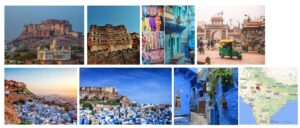[Subscribe to 365 Wow Places & Wisdom here, then send your comments to dave_blum@hotmail.com. And don’t forget to share with me your own “Wow places.” I’d love to write about them in my next post!]
Wow Place #256: Jodhpur, India
If you climb a tower and look out over a traditional Italian city like Florence or Bologna, you can expect to be greeted by a preponderance of orange and red rooftops.
If you climb a similar tower in Jerusalem, you will likely be struck by the color beige, thanks to the pale, ever-present, limestone blocks used to construct many of the buildings in town.
Amarillo, Texas is often called “Yellow” for the color of the sub-soil in the nearby creek, as well as the many yellow buildings you find within its city limits.
Isn’t it cool when a town is known not for its sights, not for its museums, not for its nightlife – but for its color?!!

Jodhpur, India is another member in the colorful-city family. Looking out from a perch atop the walls of its central fort, you can’t help but being struck by the blue-ness of it all. House after house is painted in a lovely azure hue, supposedly to signify the many Brahmins living in the city. But there are other potential reasons as well. For example, the color blue apparently keeps the interiors of the houses cool during hot summers. Moreover, Jodhpur has a history of termite infestation. For this reason, it seems, locals believe the blue hue somehow keeps the termites at bay.
During my two days in Jodhpur, no one ever sufficiently answers my questions about the color scheme. Mostly, they bob their heads from side to side and answer, “It is what it is.”
What is not a mystery, however, is how enjoyable a place like Jodhpur is to visit. You start, of course, by climbing Mehrangarh Fort, which dominates the cityscape. Built in 1456 by Rajput ruler, Rao Jodha, and reconstructed numerous times, the fort stands on a hilltop 400 feet above the surrounding plains. It boasts seven gates and houses several palaces within its grounds, known for their intricate carvings and expansive courtyards. It’s an awesome sight.
Legend has it that, in order to build his fort, the king had to dislocate a saint living on the hill – who promptly cursed him, promising that the kingdom would suffer a series of crippling droughts. When Rao Jodha tried to mollify the saint, he was told that the curse would only be lifted if someone volunteered to bury himself alive. Soon after, a resident of the kingdom stepped up and volunteered to lay down his life for the sake of the realm. Needless to say, the king erected a memorial to him.
Now that’s loyalty. (Although surely there must be easier ways to get a memorial!)
Jodhpur also hosts Umaid Bhawan Palace, one of the largest and most costly heritage hotels in the world. The main residence of the former royal family of Jodphur, the palace has 343 rooms and has been voted as the best hotel in the world.
My meager backpacker budget doesn’t allow me to stay there, alas.
Finally, Jodhpur is known for a cool ghost story. As the legend goes, Thakur Jai Singh was on his way to a festival when he stopped at a lake to quench his thirst. Before he could touch the water, a ghost appeared before him with a strange request. Unable to touch the water itself, the ghost asked Thakur to help it satiate its thirst, which Thakur soon did. As a boon, the ghost offered to build a beautiful palace and stepwell for our hero at his native village – provided that Jai Singh refrain from revealing the ghost’s identity to anyone. You know where this story is going. Before the ghost could complete his construction of the palace, Thakur blabbed about the ghost to his wife and the phantom ceased construction. You can still see the unfinished palace on the outskirts of Jodhpur – it’s a spooky place and believed to be haunted.
Jodhpur is one of the most scenic and exotic towns in the Rajasthan province and, I believe, in the entire world. You should definitely go there; it most certainly won’t make you blue.
(When my rational brain wants to know precisely why a place like Jodhpur is painted blue, and not some other color, I have to remind myself not to go down an internet rabbit hole in search of a definitive answer. Isn’t it true that sometimes it’s better to have a few things remain as a mystery? Is Thakur’s ghost story really true? Who cares? It’s a great tale! Why not leave it that? Why do your kids act the way they do? Nature or nature? Who knows? Why not call it a mystery and leave it at that!)
